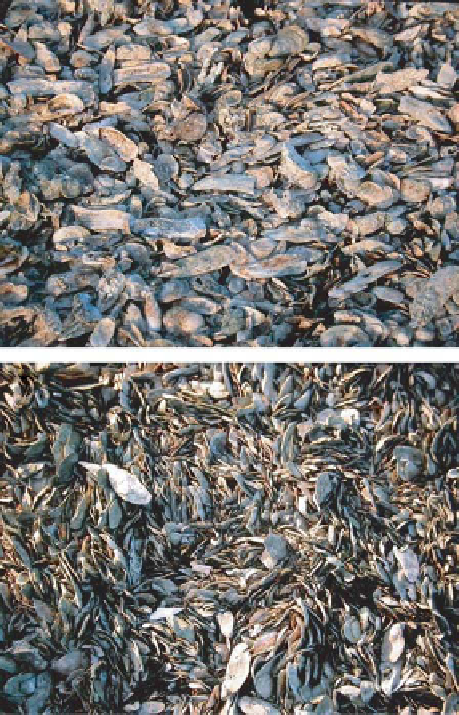Geology Reference
In-Depth Information
(a)
(b)
Fig. 3.
Storm layers of fi ne sand interbedded with lesser
energy green shale. Fine sand layers are either planar
layered with a ripple cap (foreground) or ripple lenses
(middle). Middle Cambrian Bright Angel Shale from Pipe
Springs, Grand Canyon, Arizona, USA. This is a shallow
marine epeiric sea environment over 200 km from the
cratonic margin.
reworked. Tidally reworked skeletal gravels are
generally abraded and grains, if elongate, may
organize into a fitted-fabric edgewise conglom-
erate (Fig. 4).
Fig. 4.
Oyster deposits from the seaward portion of
the Savanna River, Georgia, USA, in an area exposed to
both reversing tidal currents and incoming storm waves.
(a) view down onto a loose chaotically oriented oyster
gravel ridge thrown up by a storm event. (b) View down
onto surface of a tightly fi tted edgewise conglomerate of
oyster shell in an intertidal area persistently subjected to
strong fl ood and ebb tidal currents.
BIOTURBATION OF LAYERING
Sometimes layering does not leave a very good
record of its occurrence. This does not mean that
physical sedimentation is not important in the
more bioturbated sequences. Referring to a bur-
rowed rock from the Grand Canyon Cambrian,
colleague Francis Pettijohn responded to a ques-
tion of how deposition occurred since layering
could no longer be seen by stating: 'The rock is
burrowed not layered'. This is missing the point
but was a common concept in the 1960s and early
1970s, especially in carbonates.
In 1975, Warzeski, working on Caesar's Creek
Bank, the large carbonate tidal bank building out
into the reef tract outside southern Biscayne Bay,
showed that over half the bank's sediment was
derived from within Biscayne Bay (see Wanless
et al
., 1995). This conclusion was reached even
though the sequence was bioturbated because the
fi ner-grained skeletal constituents in the sedi-
ment sequence were from organisms that lived
only within Biscayne Bay and not in the outer
reef tract. In other words, the sediment had been
transported there and deposited as layers by
storms, then subsequently bioturbated. This may
seem obvious now, but it was not then. During
his studies Warzeski also found a 10-15-cm-thick
layer of muddy carbonate sediment just below the
surface across most of Caesar's Creek Bank (over
4 km
2
). Using historical aerial photographs, it
was concluded that this was from the 1935 Great
Labor Day Hurricane. Since this layer was identi-
fi ed in the mid-1970s, it has slowly disappeared
through bioturbation.
Risi and co-workers mapped the distribution and
fate of the storm surge layer from Hurricane Andrew
in 1992 along the southwest coast of Florida
(Risi
et al
., 1995; Risi, 1998). This 1-10-cm-thick


